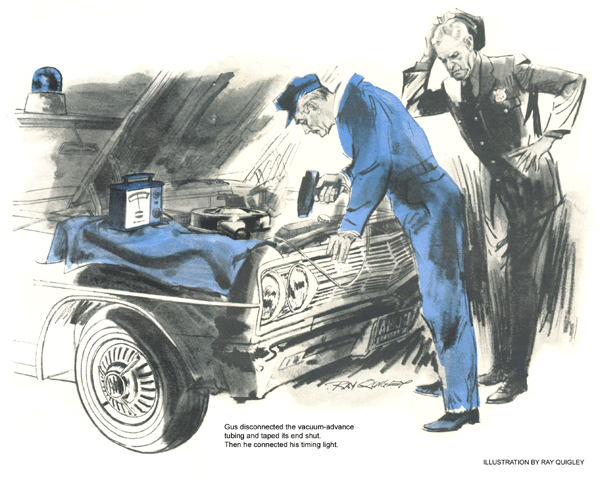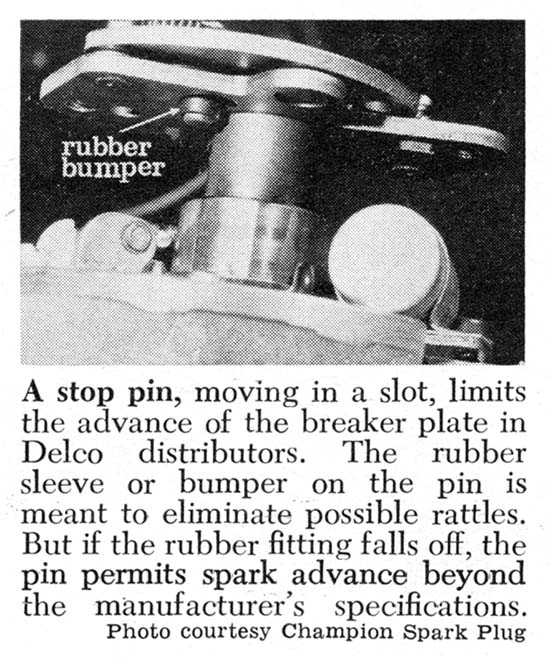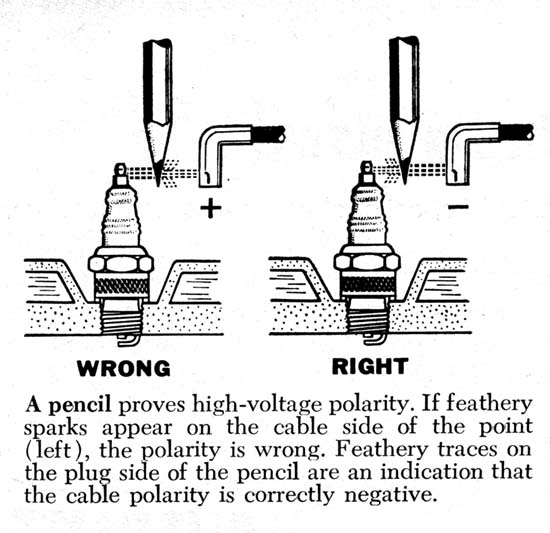September 1965
GUS CRACKS A
CASE FOR THE COPS
by Martin Bunn
Was the suspect's sedan
hot enough to run away
and hide from a patrol car?
If not, the cops had the wrong man.

Pouring himself a cup of coffee in the Model Garage office, Gus Wilson looked up to see a familiar lanky figure in the doorway.
"Morning, Sam. Have some coffee?"
Chief of Police Sam Eldon, whose heavy-lidded eyes and sagging jowls gave him the look of a sleepy hound dog, folded his length lazily into a chair.
"Can't do more than poison me," he said, taking the cup Gus handed him.
"Poison? We're more likely to be bored to death, Sam. It's been a quiet summer."
"Till last night," returned Eldon. "About four a.m. the Benton Electronics alarm system went off. It's wired to the station house, so we were there in three minutes -- just in time to see a Ford Sedan hightail it out of there.
"With Carnahan driving, we took off after it. He's good, but the other fellow was better. Held 90 all the way to Grover's Creek, then hit over 100 until we lost him on some curves. But I spotted the car as we shot past the fork at Route 117.
"When he saw he couldn't lose us, he must have decided to put on an act. He wasn't doing more than 50 when we pulled him over.
Then he started to act as if he didn't know what it was all about."
Gus set down his cup. "Reminds me of last night's late show. The chase scene was good but the ending was a flop."
"This show isn't over yet," said Eldon. "There was no loot in the car -- the alarm must have scared him off before he got down to business. But we did find a nice set of tools. He's a hard-looking character, name of Burke. Says he's a mill mechanic and that he was driving all night to get to a job in Granton by morning.
"He also says a car zipped past him just before he reached the 117 fork. I phoned the Granton mill this morning. The people there never heard of him. And those tools of his could jimmy a door or bust open a cheap safe as easily as they could be used on mill machinery."
Gus stood up. "Well, now that you've beat about the bush, what did you come for? Want me to look at his car?"
"No, not his car," said Eldon. "Mine. One of my boys tuned it last week, and it sure did fine last night. But this morning when I was doing only 60 it began to knock, and power fell off."
Opening the hood of Chief Eldon's well-groomed Chevrolet V-8, Gus figured that the man who had timed it had probably left the distributor loose. It took him only a moment to find he was wrong; the distributor was securely tightened. The spark knock Eldon described could hardly be from carbon deposits; Gus himself had ground the valves and cleaned out carbon six weeks before. The plugs showed no signs of overheating, the fan belt was tight, and the radiator well filled.
But a stuck manifold heat valve could cause local overheating that wouldn't show on the dash. Gus checked the valve. It was free, and stood in the heat-off position normal for a warm engine.
Getting out his electronic plug checker, Gus hooked up its four leads and switched on the engine. As he opened the throttle to take voltage readings at high compression, there came the unmistakable, metallic rattle of a spark knock.
The eight traces on the scope all showed firing voltage to be in the normal range. No plug gaps were worn wide, nor were any of the plugs fouled. Gus unhooked the scope, disconnected the vacuum-advance tubing from the distributor and taped its end shut. Then he connected his timing light and a tachometer.
At idle, the indicator stood at six degrees before top dead center. Gus opened the engine up to 1,600 r.p.m. The centrifugal advance moved the timing up to nine degrees. At 2,300 r.p.m., it shot up to more than 18 degrees.
"Too much spark advance at high speed," said Gus, shutting off the engine. "Could be the spark-advance springs have gotten weak."
"All of a sudden, since five a.m.?"
Gus grinned. "I'll admit springs don't usually weaken so fast unless they're overheated. This is where gadgets quit and we start thinking.
So the first thing I'll look for is a little rubber bumper."
Mystified, Eldon watched Gus remove the distributor and take it to a bench. Turning up the breaker plate, Gus looked at the stop pin.
Eldon leaned over the bench. "I don't see any bumper," he said.
"Because it isn't there." Peering into the casing, Gus fished out a small rubber fitting. "Here it is. It softened through wear and fell off the stop pin -- maybe your high-speed chase helped shake it off. Without it, the stop pin was smaller and let the breaker plate advance several degrees more before the pin hit the slot edge. As the car was already tuned for maximum high-performance advance, this was too much of a good thing. You got pre-ignition, a spark knock, and a drop in power. I'll put on a new bumper and then check out the timing."
Fifteen minutes later the police car was buttoned up and ready to go.
"Suppose you think you're pretty hot," growled Eldon, with a wink at Gus's assistant, Stan Hicks.
"There has to be somebody around to set an example for you public servants," said Gus cheerfully.
"Well, you've given me an idea," confessed Eldon. "About checking out this suspect's car. We have to book him in 24 hours or let him go. It's an old trick to use an ordinary-looking car with a real hot engine in it. You show me that's the case, and I'll charge him."
"Didn't get his license number at the scene of the crime, did you?" asked Gus.
"No," said Eldon. "But we saw him scrape a fender in tearing out of the alley. This car has the marks -- of course the suspect says they were made somewhere else, two days ago. Come on, get in and let's go."
In the courtyard of the station house stood a three-year-old Ford sedan. The body had been well cared for, right down to the chrome.
The engine also showed signs of care. Its block was remarkably clean, oil and radiator coolant clear. But two plugs were newer and of a different brand than the rest. The carburetor and ignition systems were standard. Gus could find no sign of a special head or other high-performance parts.
That didn't prove they weren't there, or that the standard engine wasn't well tuned and capable of hot performance. Gus inspected the battery posts, the coil, and the two wires that ran from its low-voltage terminals.
"Can't we start it up?" he asked Eldon.
The chief nodded to a patrolman, who had brought the keys. He fired up the engine. It settled into a fast idle.
With his handkerchief, Gus pulled off one of the plug cables. Taking a wooden pencil from his pocket, he held it near the plug terminal, then brought the cable end near the other side of the pencil.
Sparks jumped, flared into tiny blue feathers on the cable side of the pencil graphite, and streaked across to the plug terminal. Gus stuck the pencil back into his pocket and replaced the cable.
"What was all that?" asked Eldon.
"I don't know about the man," said Gus, "but you've sure got the wrong car. This one never ran away from you at 90."
"How do you know?"
"It couldn't have," said Gus. "You couldn't push it over 75. The coil polarity is reversed. This pencil test is an easy way to show it. If the spark feathers are on the plug side of the pencil, polarity is okay. But when the feathers are on the cable side, the positive of the high voltage is connected to the center plug electrodes. That ruins performance, because it will take much more voltage to fire a plug."
"Don't see why," said Eldon. "Most cars have the negative battery post grounded, but some have the positive."
Gus grinned. "Makes no difference whether a car has negative or positive battery ground. The high-voltage polarity should always be negative at the plug terminals. It boils down to something called electron emission, on the theory that current is a flow of electrons, from the negative side to the positive.
"The hotter something is, the easier electrons can hop off it. The center electrode of a spark plug gets much hotter than the outside one, which is attached to the shell and loses heat to it. So for easiest current flow and the best spark, the hot center electrode should be negative. If you make the outer electrode negative, you're forcing electrons to jump off a cooler surface to a hotter one. That's like bucking one-way traffic in the Friday-night rush hour."
"The engine runs, so there must be an ignition spark," said Eldon.
"Sure, at ordinary speeds. But spark-plug engineers say it takes up to 45 percent more voltage to fire a plug with reversed polarity. That cuts down on your voltage reserve. On heavy acceleration, when compression goes up and it's harder for the spark to jump, you get misfiring. Same thing at high speeds, when the points can't stay closed enough to build up a maximum magnetic field in the coil. Sam, this car couldn't have got away from you, let alone run for miles at over 90."
"Okay, maybe it couldn't. Now what does it take to reverse this polarity?"
Gus pointed to the coil terminals. "Just switching around these two wires."
"Maybe he switched them the wrong way while we were turning around, to give himself an out."
Gus laughed. "This engine's clean, but those terminals are caked with enough dirt to prove they haven't been loosened in months. Even if he had time to switch the wires, he couldn't have faked that. Better let the man go, Sam."
"I had a hunch I should, but I couldn't put a reason to it. Now you have. Guess that's why I put up with your bum coffee."
"Come around in the morning," said Gus. "I'll have a fresh pot on."
To his surprise, Chief Eldon did show up for coffee the next morning, looking as if he hadn't been to bed.
"Busy night, Sam?" asked Gus.
Eldon sipped the black brew morosely. "Had to check out what you said about that car, Gus, so I drove it. Began to sputter at 55, and never would hit 70. Then I switched those two wires. Made a big difference. I released Burke. He's probably wondering," concluded the chief, "why his car runs so much better."
"Too bad the real crook got away."
"Oh, we got a flash about that. A man broke into a contractor's office upstate, then walked into two patrolmen -- with the loot on him -- while heading for his car. Same make and model, but sassed up like for Indianapolis. Must be the one we chased -- that fellow sure didn't have his ignition switched around the wrong way."
"Guess not," said Gus. "His mistake was trying to switch around other people's money."
END

